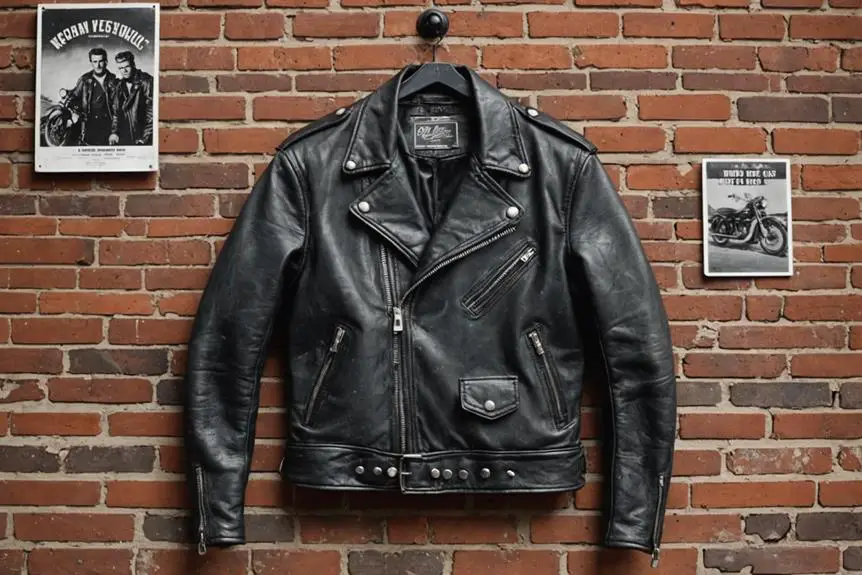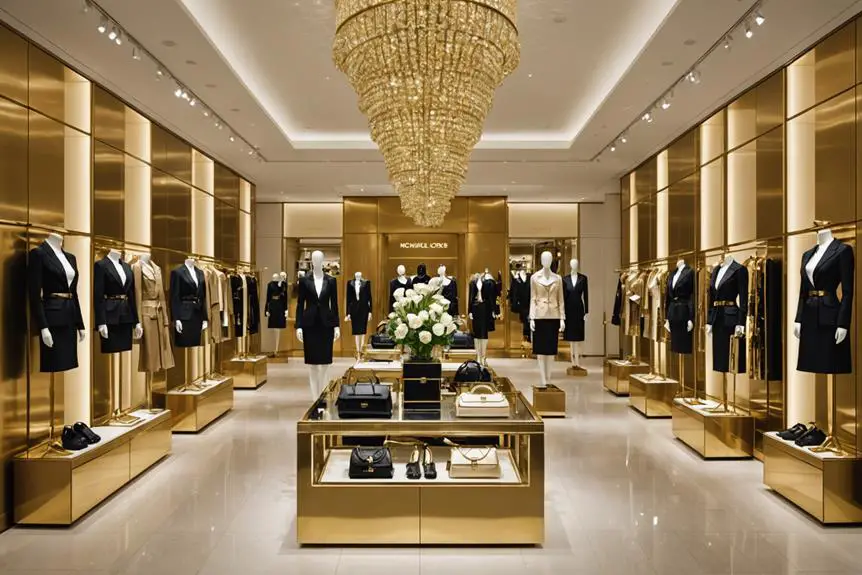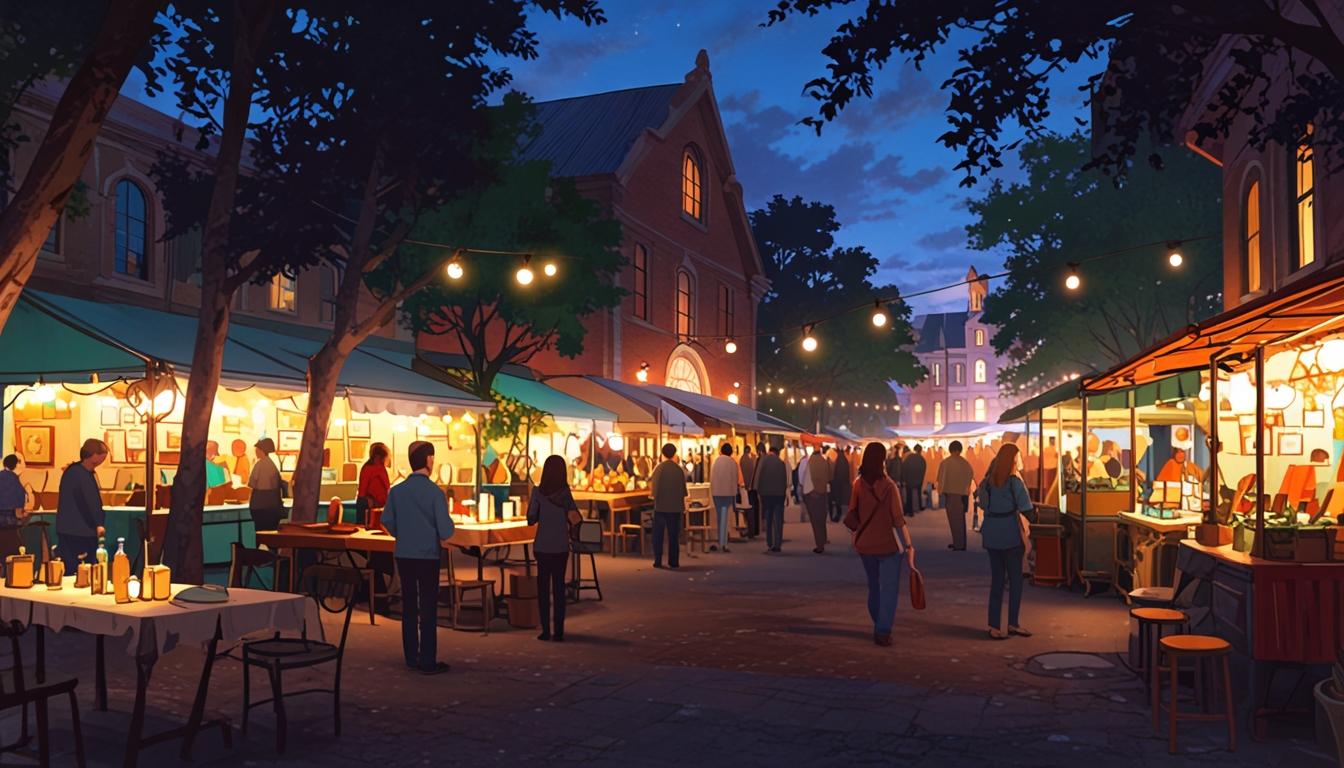Imagine you're flipping through a vintage magazine and spot Marlon Brando in a leather moto jacket, exuding an air of rebellion. This iconic image not only captures the essence of the 1950s but also marks a pivotal moment in fashion history. The moto jacket's journey from a practical bikers' garment to a cultural symbol is fascinating, yet the story doesn't end there. As you explore its evolution through various decades, you'll discover how it transformed alongside society and continues to influence fashion today.
Origins of the Moto Jacket
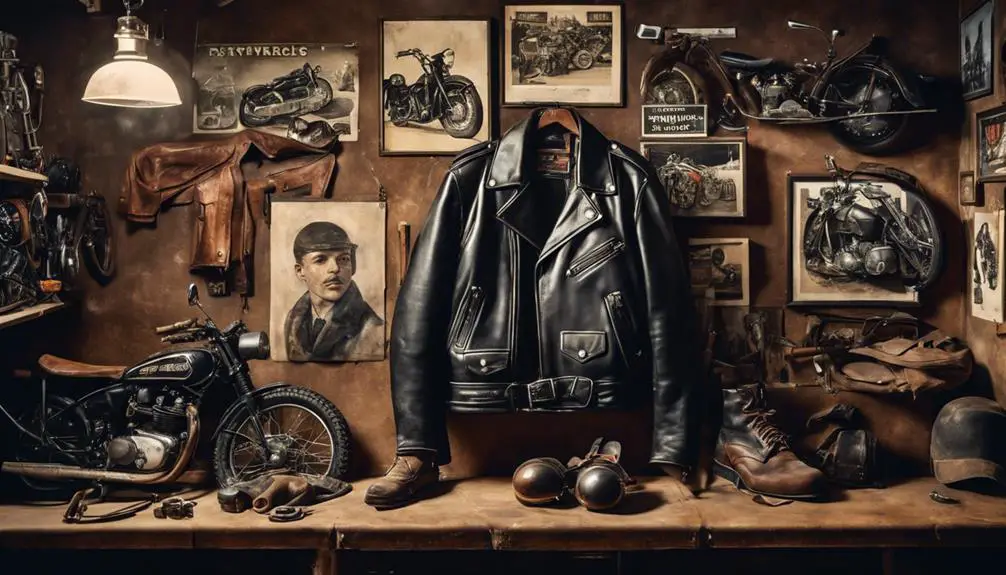
The origins of the moto jacket date back to 1913, when Irving and Jack Schott of Schott NYC designed the first biker jacket specifically for motorcycle riders. This groundbreaking piece, known as the Perfecto, was crafted with the rider's needs in mind, blending style with functionality. Imagine zipping up a jacket that not only protects you from the wind but also makes a bold statement on the road. The Perfecto wasn't just any jacket; it was the first motorcycle jacket marketed for Harley Davidson, and it featured fully functioning zippers, a novel idea at the time. Priced at $5.50—equivalent to about $76 today—it represented a significant investment for riders who craved both safety and style. Named after Schott's favorite cigar shape, the Perfecto symbolized adventure and danger, vibrant elements that resonate deeply with motorcycle culture.
The legacy of the moto jacket continued to evolve as other brands, such as Barbour, began to create their own iconic pieces that also catered to the outdoor and riding communities, showcasing the versatility and enduring appeal of these jackets in fashion and function. vintage Barbour tags played a significant role in identifying the rich history behind these garments, adding layers of storytelling to the fashion landscape. Irving and Jack Schott meticulously designed the Perfecto with heavy-grade leather for durability and warmth provided by wool lining. As you don this iconic biker jacket, you're not just wearing a piece of clothing; you're donning a slice of history. The motorcycle jacket became a staple not only for riders but also for those who embraced the rebellious spirit of the era. During the 1940s, production of civilian leather jackets paused as Schott shifted to support the U.S. military with bomber and flight jackets, but the legacy of the moto jacket was already firmly established.
Rise in Popularity
Marlon Brando's iconic performance in "The Wild One" catapulted the moto jacket into the spotlight during the 1950s, transforming it into a symbol of rebellion. His choice of the Perfecto jacket not only defined the style but also sparked a surge in demand, leading to schools banning the garment due to its associations with gang culture and delinquency. It was a time when the biker jacket became synonymous with youth defiance, much like how vintage apparel, such as Ralph Lauren, reflects distinct cultural moments in fashion history identifying vintage garments.
As the 1960s rolled in, the jacket solidified its place in the wardrobes of musicians and counterculture icons, who embraced its edgy aesthetic. With its rich history rooted in rebellion, the biker jacket became a staple in the fashion of rock 'n' roll legends, influencing generations to come. The punk rock movement of the 1970s further propelled its popularity, as bands like The Ramones donned the jacket as a uniform, representing anti-establishment sentiments and a fierce subculture.
Cultural Impact of the 1950s
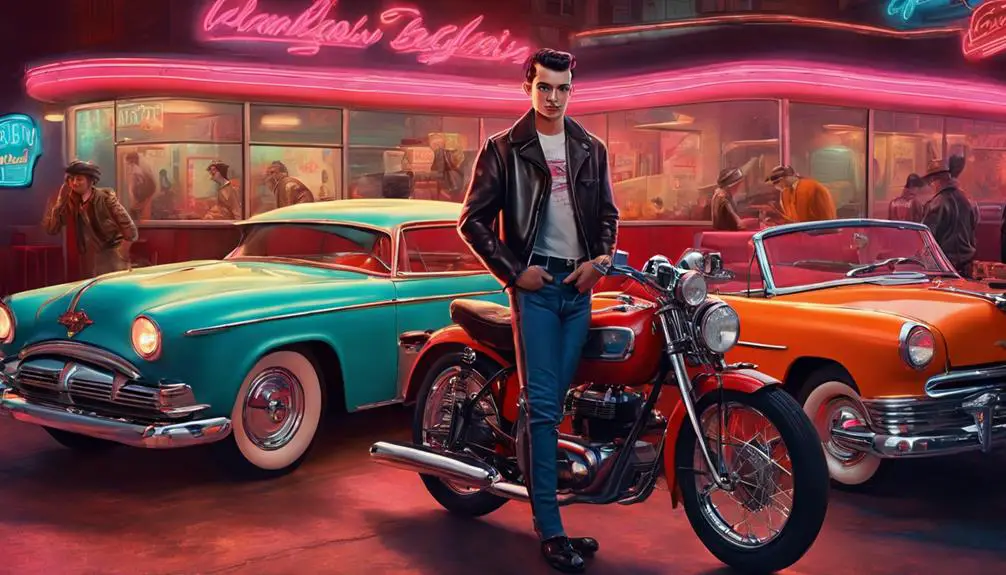
Rebellion defined the cultural landscape of the 1950s, with the biker jacket at its forefront. This iconic piece of clothing gained immense popularity, especially after Marlon Brando donned the Perfecto jacket in the 1953 film "The Wild One." His portrayal of Johnny Strabler didn't just entertain; it captured the spirit of youth culture and sparked anti-establishment sentiments that resonated deeply across America. Suddenly, the biker jacket became a symbol of defiance, a way for young people to express their individuality and resistance to societal norms. The Harley Davidson brand, with its deep-rooted cultural legacy and community, also played a pivotal role in solidifying the biker image during this era, fostering a sense of belonging among riders and enthusiasts Harley Davidson Cultural Legacy.
As Brando's influence spread, schools began banning leather jackets, fearing they would incite gang violence and further rebellion. Yet, this only solidified the biker jacket's status as an American classic, a must-have for rebellious youths keen to push back against authority. Hollywood icons like James Dean, who embodied the same spirit in "Rebel Without a Cause," further embedded the jacket into the fabric of 1950s youth identity, making it a staple in wardrobes nationwide.
Fashion trends of the era shifted dramatically as young people embraced the biker jacket, transforming it into a potent symbol of freedom and nonconformity. It wasn't just clothing; it was a statement, a call to arms for those eager to challenge the status quo. The cultural impact of the biker jacket during this vibrant decade laid the groundwork for its lasting legacy, ensuring that it remains a powerful emblem of rebellion and youth culture for generations to come.
Evolution Through the 1960s-80s
As the 1960s unfolded, the biker jacket evolved into a powerful counterculture symbol, embraced by influential musicians like The Beatles. This iconic motorcycle jacket mirrored the spirit of freedom and experimentation that defined the era, becoming a staple in the wardrobes of those seeking to express their individuality. The jacket gained further traction in the 1970s, when it was adopted as a uniform by legendary rock bands such as The Ramones, solidifying its status within the punk rock movement and the broader youth rebellion. During this time, brands like Stussy began to emerge, capturing the essence of youth culture through innovative streetwear, reflecting a similar ethos of rebellion and self-expression found in the biker jacket's legacy vintage identification resources.
By the 1980s, the punk scene transformed the biker jacket's aesthetic dramatically. You'd notice oversized fits paired with metal spikes and studs, all reflecting a fierce anti-establishment sentiment. Designers like Vivienne Westwood played a pivotal role during this period, infusing the jacket with bold, punk aesthetics that challenged traditional fashion norms. The heavy guitar riffs of bands like the Sex Pistols and The Ramones not only shaped the music scene but also influenced the styling of the biker jacket, embedding it deeply into the cultural fabric of the punk rock era.
Indeed, the evolution of the biker jacket throughout these decades showcased its ability to adapt and resonate with changing societal attitudes. As it shifted from a symbol of rebellion to a fashion statement, it demonstrated the power of clothing as a form of self-expression and resistance, further entrenching its legacy in the world of fashion and music.
Resurgence in the 1990s
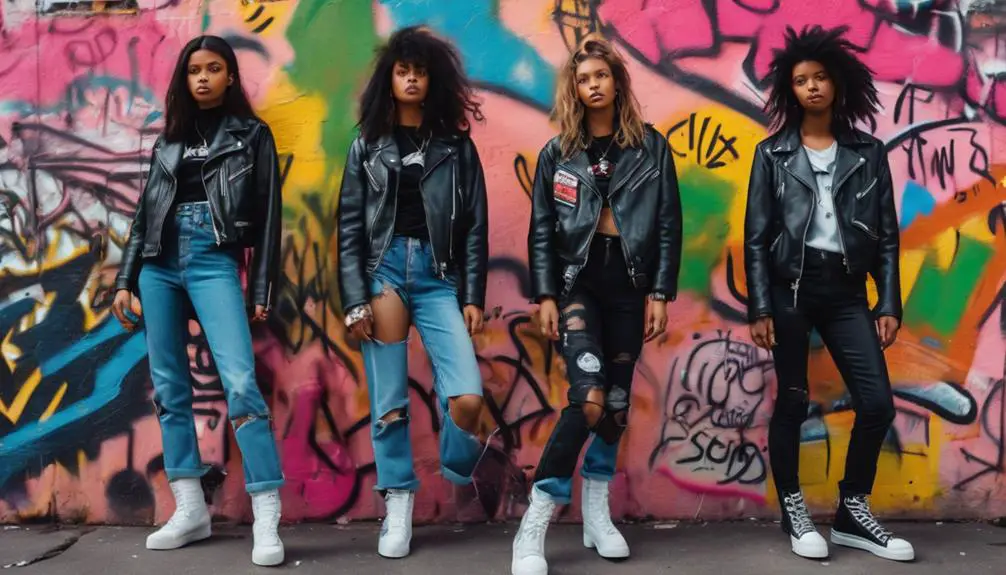
The biker jacket roared back into the spotlight in the 1990s, thanks in part to Hollywood A-listers like Johnny Depp and Leonardo DiCaprio who sported the style. Their influence helped reinvigorate the biker jacket's popularity, making it a must-have for fashion enthusiasts everywhere. This decade marked a significant shift, as the biker jacket evolved into a versatile fashion piece that appealed to a much broader audience. You could find designs ranging from high-street brands to luxury designers, creating options for every budget and taste.
During the 1990s, the biker jacket became synonymous with grunge fashion, perfectly capturing the rebellious spirit of the time. With alternative rock bands like Nirvana and Pearl Jam dominating the music scene, the jacket became a staple in the wardrobes of diverse demographics, from teenagers to young adults. Its rugged appeal resonated deeply, making it a symbol of counterculture.
The adaptation of the biker jacket in this era was exciting, as styles and finishes diversified. Cropped silhouettes and vibrant colors emerged, moving away from the traditional all-black leather look. This invigorating take allowed you to express your individuality while still embracing the jacket's iconic legacy. The 1990s truly solidified the biker jacket's status as a fashion essential, proving it could adapt to changing trends while maintaining its edgy charm. So, whether you're rocking it with a band tee or dressing it up for a night out, the biker jacket remains a timeless choice!
Contemporary Styles and Designers
Today, many contemporary designers are breathing new life into the classic biker jacket, transforming it into a statement piece that reflects modern sensibilities. Designers like Rick Owens and Yves Saint Laurent have reinterpreted the traditional biker jacket, integrating avant-garde elements and luxurious detailing to elevate its status in high fashion. You can see how these innovative silhouettes push boundaries, making the biker jacket a canvas for artistic expression.
Acne Studios stands out with its minimalist cropped biker jacket, skillfully maintaining the classic appeal while catering to modern aesthetics and trends. On the other hand, Gucci's leather racer jacket combines rugged toughness with vibrant silk lining and printed lyrics, showcasing a delightful fusion of durability and playful design.
Schott's Classic Perfecto remains a quintessential style, crafted from heavyweight cowhide that boasts enduring quality and authenticity. This timeless piece captures the essence of the original biker jacket, ensuring it remains relevant. Meanwhile, Daniel W Fletcher's designs incorporate vibrant colors, reflecting a bold shift in contemporary fashion that invites wearers to express their individuality.
With these exciting developments, the biker jacket continues to evolve, proving that it's more than just a functional garment; it's a dynamic fashion statement that bridges the gap between tradition and modernity. As you explore the contemporary styles, you'll surely find a biker jacket that resonates with your unique style and showcases your personality.
Styling the Moto Jacket
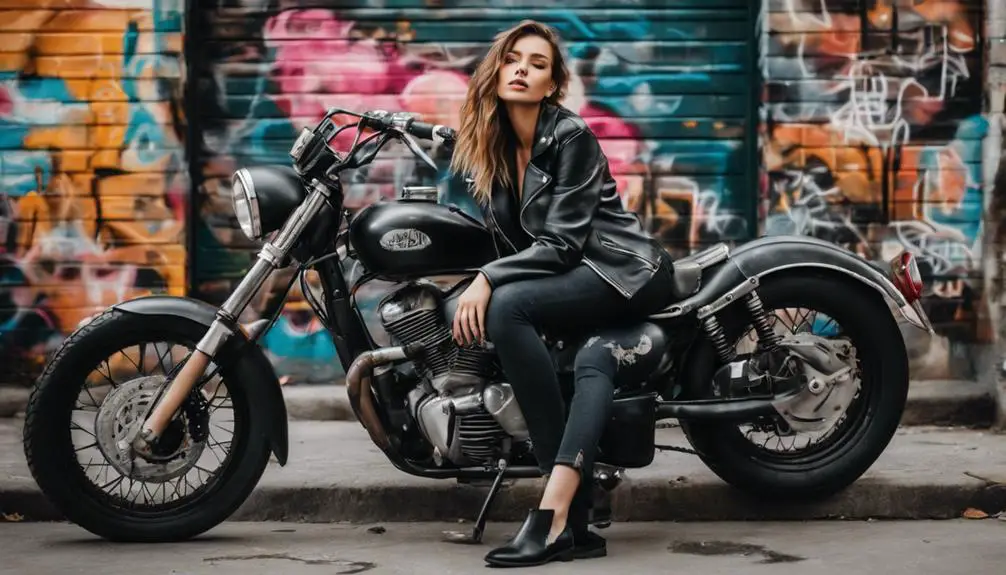
Styling a moto jacket can transform your outfit, making it effortlessly chic. To achieve a classic look, pair your moto jacket with raw selvedge denim and a plain white T-shirt. This timeless combination offers a laid-back vibe that never goes out of style, perfect for casual outings or weekend adventures. If you're aiming for a more polished outfit, consider teaming your moto jacket with a crisp white button-down shirt and straight-leg trousers. This combination strikes a balance between relaxed and refined, ensuring you look put-together without sacrificing comfort.
Tucking in your shirt can elevate your outfit to a refined look, while leaving it untucked creates an easygoing smart-casual style that's ideal for brunch or casual Fridays at work. When it comes to footwear options, black boots or Chelsea boots are fantastic choices that enhance the overall edgy aesthetic of the moto jacket.
To further personalize your ensemble, accessorize with a simple scarf or incorporate statement jewelry that showcases your unique style. Whether you choose bold earrings or a chunky bracelet, these details can truly elevate your look. Remember, the moto jacket is a versatile piece that can seamlessly shift from day to night, so don't hesitate to experiment with different styles and accessories. Embrace your creativity, and let your moto jacket reflect your personality!
Frequently Asked Questions
Why Is It Called a Moto Jacket?
It's called a moto jacket due to its roots in motorcycle culture. Its design evolved through fashion influence, with punk aesthetics, celebrity endorsements, and diverse material choices, making it an iconic piece in modern interpretations and color variations.
When Were Moto Jackets Popular?
Moto jackets gained popularity in the 1950s during rebellion, embraced by motorcycle culture and rock music. Fashion icons, punk movement, and celebrity endorsements fueled their rise, influencing street style and leading to modern adaptations through leather innovation.
What Is the History of the Peacoat Jacket?
Think of the peacoat as a sailor's embrace, originating in the 19th century. Its wool fabric shifted from military uniforms to modern adaptations, showcasing designer influence and cultural significance in seasonal trends and evolving naval fashion.
What Makes a Jacket a Moto Jacket?
A moto jacket stands out through its design elements like asymmetrical zippers and snug fits. You'll love the fabric choices and color options, plus celebrity influence and style variations make it a versatile, culturally significant piece.
